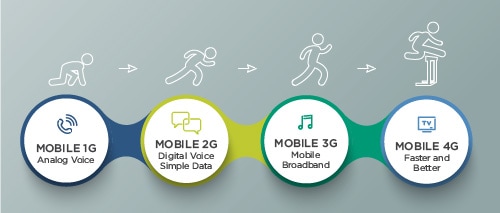
With ever-increasing speeds, accessing the web from your mobile device has become even more convenient and sometimes faster than using your home computer. This is the type of technology that brings “mobile” lifestyle to the next level, giving us the ability to do anything from anywhere.For years smartphone ownership has been on the rise, with 80% of adults owning at least one smartphone and spending about 11 hours a day with electronic media. Without network expansion, this increase in data demand can negatively affect the performance of your smartphone by reducing speeds. We can probably all agree, it is extremely frustrating trying to visit a page or watch a video and the data just isn’t working. We want our internet to be faster; we need our internet to be faster. Our everyday lives changed after the introduction of 3G technology and mobile data usage, and with the spread of 4G LTE, life will just get better. So what makes 4G LTE so great?
With real speeds of up to 1 GB per second, 4G or “4th generation” mobile data is up to 10 times faster than 3G. This means that an MP3 file downloaded on a 4G network would only take 10 seconds whereas the same file would take 4 minutes on a 3G network. 4G capabilities are ideal to fully enjoy what smartphones have to offer.
The fastest wireless transmission yet, even faster than the previously mentioned 4G, is that of the 4G LTE (Long Term Evolution) network. In the perfect scenario, 4G LTE networks can download data at speeds between 5 and 12 MB per second, allowing users to stream video live or play multi-player games with almost no interruption. In reality, 4G LTE only reaches download speeds of 3 to 8 MB per second due to network congestion. This is a result of poor 4G LTE coverage as the technology continues to be rolled out.
Continued construction and expansion of the 4G LTE network may appear encouraging to mobile phone mast lease owners because of the implied security it brings, but existing phone mast sites are not as secure as they may seem. Numerous factors play a role in identifying the optimal location for a 4G site. Occasionally this will mean modifying an existing 3G site to accommodate the new technology but it could also mean building a brand new mobile phone mast or rooftop installation in a different location. With new phone mast sites and better technology on existing sites, coverage overlap is inevitable. Redundancy in coverage is a wasted expense for telecoms operators and simply isn’t cost effective. In an effort to reduce unnecessary expenses, telecoms operators must make the decision to terminate lease agreements or even mobile phone masts all together.
In the end, the network becomes faster and more reliable, which is great for the population as a whole. However, this is little consolation to those individual property owners who end up losing their mast site rent as the network changes.